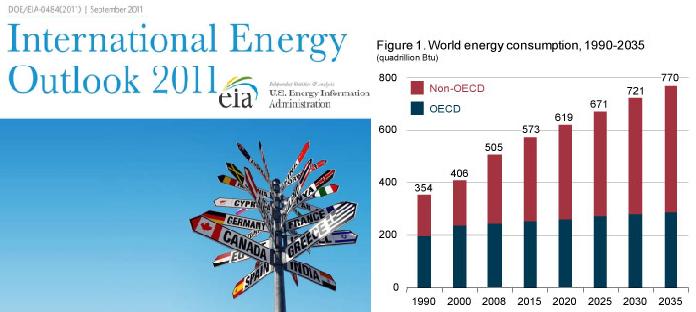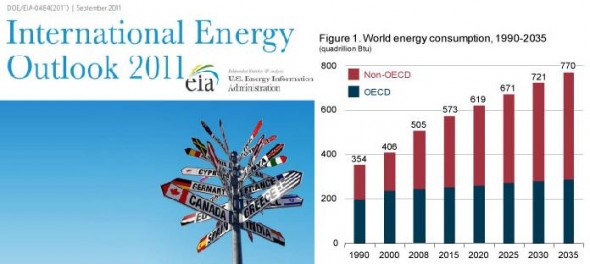EIA Report: Global Energy Use To Grow 50 Percent by 2035 — Half of Increase from Fossil Fuels in China and India
The U.S. Energy Information Administration recently published its annual report on global energy projections. Though renewable energy sources and nuclear power, along with unconventional fossil fuels, will phase out coal production over the next two decades, it will not be at the pace necessary to offset greenhouse gas emissions.
Global energy consumption will increase by 53 percent over the next 25 years to a mind-boggling 225,700 terawatt-hours (770 quadrillion BTUs ) as water- and carbon-intensive fossil fuels continue to dominate the world’s economies, despite the global recession and the strong growth in the renewable sector, according to a new annual report by the U.S. Energy Information Administration (EIA).
About half of the projected increase in energy use will occur in China and India, the world’s first- and third-largest energy consumers, respectively. The two developing economies will account for more than 30 percent of the global energy use during the next two decades.
“China alone — which only recently became the world’s top energy consumer — is projected to use 68 percent more energy than the United States by 2035,” said Howard Gruenspecht, the administrator for the EIA, in a press release.
In general, however, the overall projections made in the EIA report only reflect laws and policies as they stood at the beginning of 2011. In other words, the report does not incorporate prospective legislation — in China, for example — that, together with oil-price volatility and the pace of global economic recovery, could significantly affect energy markets.
Coal Production and Consumption
China relies on coal for about 70 percent of its energy generation, consuming 3.15 billion metric tons (3.5 billion tons) of coal last year. Meanwhile, India has been steadily increasing domestic coal production, its major source of energy, reaching about 532 million metric tons in 2009-10.
Though future generation from renewables, natural gas, and nuclear power will largely displace coal-fired production, coal will remain the largest source of world electricity through 2035, particularly in developing nations, according to the EIA projections. China alone will account for 76 percent of the projected increase in world coal use.
Unconventional Gas and Oil
Nevertheless, natural gas production will have the fastest growth rate among fossil fuels. The natural gas industry is already reaping a bonanza from its unconventional fuel production in the United States, and is expected to significantly expand into Canada and China.
Though world oil prices will remain high during the next few decades — even reaching $US 125 per barrel in 2035 — conventional and unconventional oil consumption is likely to continue to grow to meet rising global demand.
Renewable Alternatives
Renewable energy is projected to be the fastest-growing source of primary energy over the next 25 years, with most of the increase due to newly installed hydropower capacity in the developing world.
However, this will do little to offset the emission of greenhouse gases globally, which are likely to increase by more than 40 percent during that same period. The report did not analyze the overall impact on global water resources.
Driven by new installed capacity — predominantly in China, Russia, and India — electricity generation from nuclear power is also expected to increase from 2,600 terawatt-hours (8.9 quadrillion BTUs) worldwide in 2008 to 4,900 terawatt-hours (16.7 quadrillion BTUs) in 2035.
Nukes
Though the study acknowledged that there is still “considerable uncertainty about the future of nuclear power” with regard to plant safety, radioactive waste disposal, and proliferation of nuclear materials, the report failed to analyze the short- and long-term implications of the March 2011 disaster at Japan’s Fukushima Daiichi nuclear power plant. For instance, Germany, Switzerland and Italy, in particular, have already announced plans to phase out or cancel all of their existing and future reactors within the next decade.
Source: U.S. Energy Information Administration, India’s Ministry of Coal, Talking Points Memo
, a Bulgaria native, is a Chicago-based reporter for Circle of Blue. She co-writes The Stream, a daily digest of international water news trends.
Interests: Europe, China, Environmental Policy, International Security.









We cannot allow the bleak reality of the world’s energy production and consumption deter us from innovating and implementing sustainable practices. This will first be a race between nations to become the most energy efficient and autonomous country on the planet. Then, it will be a unified necessity that determines which cultures survive and which cultures are forgotten by history. America must prioritize resource sustainability over economic dominance if forced to choose one over the other.
The solar power is the perfect solution for the future.The use of solar power can control the level of pollution, as the process of generating electricity from sunlight cause no pollutants.